Cob Building In The Counrty
Some things just have to be experienced. Cob building is one of those things. Of all the earth-building methods, cob building embodies a mystery in its sensuous curvy walls. How does it work? How does it get built? While straw bale building is easily visualized by looking at pictures - you see the bales, then the walls, the roof and there you have it, a house - cob building is better understood as pottery or sculpture.
I had long been looking for a cob building experience. There was a workshop being offered in the north of Thailand to build housing for orphans - an international exchange of ideas. What could be cooler than that? Alas the event conflicted with chapter meetings of NAPO for which I was program director. Besides I had flown so much last year I would have to plant 900 hundred trees to make up for my carbon emissions output. Much better to find something closer to home. So when the Solar Living Institute offered a five-day cob-building workshop near Santa Barbara I signed up.
It was a misty cool morning when I arrived at Orella Ranch. Driving straight up the hill on a dirt road, I found myself at the building site looking at an expanse of clover lawn at the end of which was a somewhat kidney shaped foundation built from broken blocks of concrete. A crew was already at work, finishing up the mortaring of the concrete blocks. I introduced myself to Sasha, the workshop leader. As soon as the rest of the participants arrived she began directing us in the art of making cob.
With cob, you just have to jump in and do it. Before setting up camp, before introductions and a lecture on the history of mud hut building, you take off your shoes, roll up your pant legs and stomp in the mud. And here I was worried about what shoes to bring.
We paired up and each got a blue tarp and a couple of five gallon buckets. There was a recipe. One and a half buckets of sand to one bucket of mud. (The sand would keep the mud from cracking; we later made it two buckets because the mud still cracked). A young intern was standing in the mud pit, breaking down the clods as we filled up buckets. The dark chocolate colored mud, we poured onto the brown sugar sand, then stepped into it and mixed, mixed, mixed just like that other more famous stomping of grapes. To assist in the mixing we rolled the dough up in the tarp like a burrito, then uncovered it to find a body shaped like a seal. We stomped it down into a pancake again. Once no sand was showing, we added straw. The yellow straw stuck up in the dark mud as we stomped it in.
Then, if it wasn't enough to get your feet completely muddy, we were to grab the mix and make footballs. Now thick with straw fibers, we had cob. Sasha had us form a bucket brigade and we tossed the cob footballs to each other towards the building site. That was the fun part. I was as happy as a pig in, er, mud. Really what could be more like play? I hadn't seen my feet this muddy since I was nine. Everyone had a smile on their face.
Then we introduced ourselves. We had an environmental engineer who worked with oil refineries, a stain glass artist who also made ceramics, an auto mechanic with his own shop in Ventura, his wife who ran a wholesale jewelry business, a pre-school teacher, three college age interns and Guner the owner, whose great, great, great grandfather had farmed this land after an oil company had explored it and moved on. We could still see the four waist high cement footings in the road where an oil-drilling platform would have been built, had there been oil. I pitched my tent next to one. The view from this site was a stunning one of the coastline all the way to Santa Barbara and out to the Channel Islands.
The structure we were building with Guner and his friends was a storage shed. But more than that it was a party house. This was the lawn where Guner and his wife had gotten married. Many more celebrations were expected and the storage shed would have a cob oven at the end of it and a long built-in bench to take in the fabulous view. (I secretly hoped to return once the building was completed. Few buildings are completed by a workshop alone.)
We soon began to apply the cob to the foundation. Here again was a technique unlike any I had ever applied. I thought at first that the cob footballs would serve as bricks, but no, it was to be pressed together. After the first layer was smeared onto the cement foundation, the second layer was pressed onto the first and knitted together with our thumbs. That is, we pressed the straw from the new layer into the layer below, thus tying the two layers together. It took me a while to wrap my mind around it, though it was not hard to do.
After the first day we had a cob wall not quite a foot high. This was basically it. The growing of a building. We tried to keep the walls plumb with a level as we worked, but if they bulged we let it dry and came back the next session to trim the bulge with a wood saw. If it was receding we wetted the dent and pressed more mud onto the spot using clay slip to glue it. The dried wall had a rough natural look, which we would later cover with a mud plaster, that could then be painted.
When Sasha told us she had built her own little house, mostly by herself, and that it was 16 feet high at one end to accommodate a loft, I couldn't have been more impressed. We had a dozen people on our crew, all mixing as much cob as we could every morning. Then most of the afternoon was spent pressing the cob onto the wall. In a week or two, we would have achieved the height needed. It took Sasha all of spring, summer and fall to finish her house, hauling buckets of cob up scaffolding. A carpenter friend helped her with cutting rafters for the roof. The house was roofed with corrugated tin.
In Devon, England where our style of cob building is native, the traditional roof is thatch. As long as the roof was maintained the building could last for centuries. I asked Sasha if there were cob workshops given in England. None. Not even by Americans. And though there was an award winning cob-building company that restored traditional thatched houses, no one in England seemed to be interested in learning to build with cob. In Thailand, however, where the native building material is wood, the cob workshops given by an American couple, draw hundreds wanting to learn the "new" building method that was so cheap and easy to do.
It was also communal. Cob builders were in the habit of helping each other build houses. Without the noise of hammers and power tools, it was a very pleasant way to get to know people. I soon learned that cob builders were of a progressive, environmental bent. One young woman was certified in permaculture, another was studying natural building design at an alternative college and had worked with a natural plastering company. The couple from Ventura had seen even more alternative documentaries than I had. The pre-school teacher offered her opinions on the Bush regime.
The Santa Anna winds blew in with their eerie heat. Then it turned hot. In the late afternoon when we were weary from the day, Guner's friends showed up with fresh energy and interest to finish off our work. Then the dinner crew arrived with veggie casseroles and lively conversation. We met the whole family.
Gunner himself had graduated from Humboldt with a self-created degree in eco tourism, then sailed someone else's boat to Australia over two years. Now he was a carpenter working with salvaged materials and fallen trees he milled himself. On a break we took a tour of his workshop and living space. It was in a canvas dome fitted with handcrafted custom cabinetry. I interviewed him extensively about his homemade composting toilets with their red worms. He was doing everything I had only read about in books. I felt like a dilettante.
What fun these country people were having. I was tempted to move to a rural area and become a homesteader myself. The back-to-the-land movement of the 70's fizzled out largely because not enough people had homesteading skills, but this generation did, and I too was learning. The more I learned about earthen buildings (from the stack of books Sasha brought) the more I realized how smart people used to be. Here they were not only using local, sustainable materials to build with, but their houses lasted for centuries. It made our stick and drywall, plywood palaces look like a theatrical stage set in comparison.
As we worked together on the oven part of the project, we stood intimately in a tight circle, pressing mud over the pregnant belly of the wet sand form. I asked my new friends if there was still a place for the passing around of ideas, even though there was very little actual commitment to transforming the consumer driven lifestyle. Ideas being the currency of writers. All I got was a snort from Sasha and a look of disgust from my 23-year-old permaculture intern. Clearly this was precisely the problem with even a progressive mecca like the Bay Area. We all loved that there were ideas, but few actually changed their lifestyles. I too, was disgruntled with this state of things and didn't want to leave my mud hut playground.
How quickly I had taken on the rhythm and pace of cob, the simplicity of the country. When I came home, I was disoriented as though I had been out at sea for a month. The next day I was to lead a bicycle contingent on the Solar Homes tour in San Francisco, but I could hardly follow the directions. I relied on my group of 20 bicyclists to navigate the traffic.
As we toured the homes of solar enthusiasts, I realized that here too, were examples of serious commitment to transforming energy consumption in our consumer lifestyle. We might call ourselves solar homesteaders. And yes, lots of ideas were shared. Still, I had been deeply affected by the feel of cob in my hands; I had gained a deeper appreciation for what we could do with just the materials at hand, the very soil under our feet. Not only could we grow our food in it, but we could grow our houses too. I had no idea mud could be so clever.
Also poste at energy bulletin
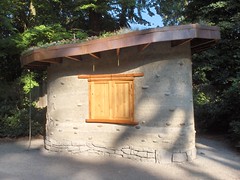
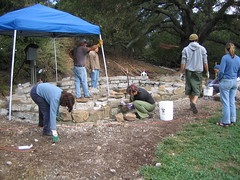
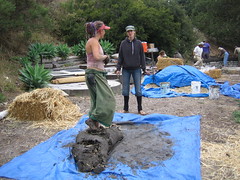
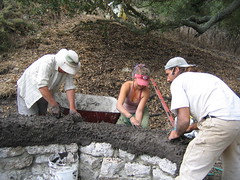
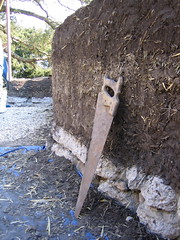
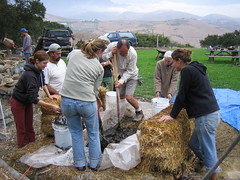
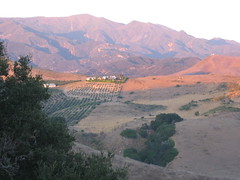
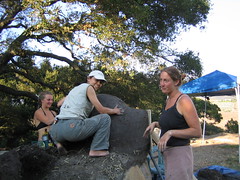
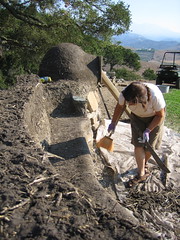




2 Comments:
Thank you dearly for sharing your experience. I too am following my facination and passion
for mud .I am drinking with such thirst all knowledge and experiences I can find,to share with others in my art residency's.
Your words will become part of my
teachings.
Thank you,
Rebecca Owens
Loved reading tthis thanks
Post a Comment
<< Home